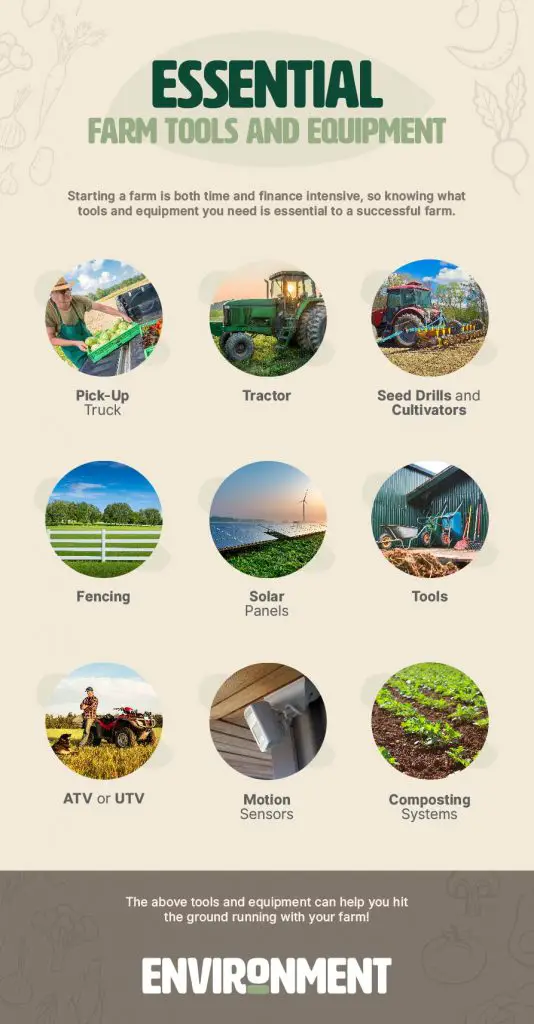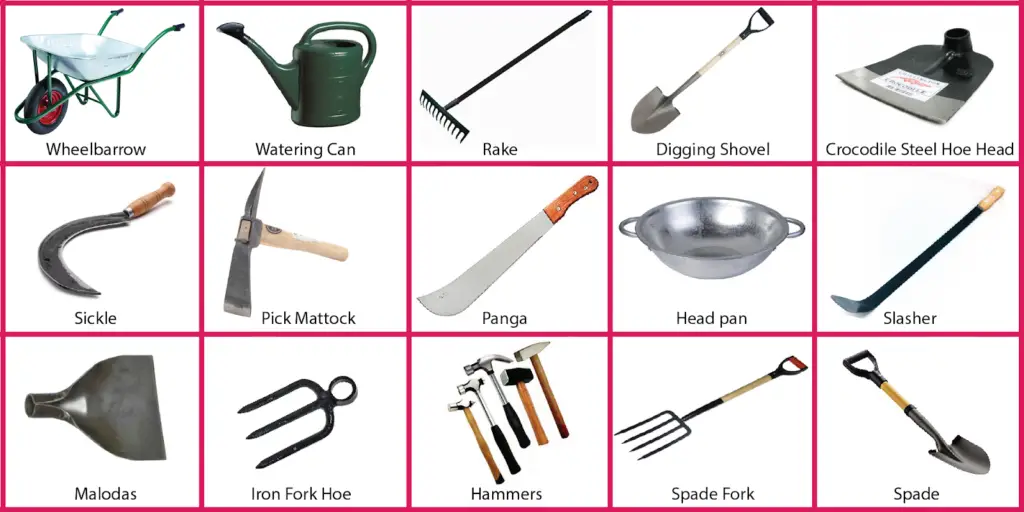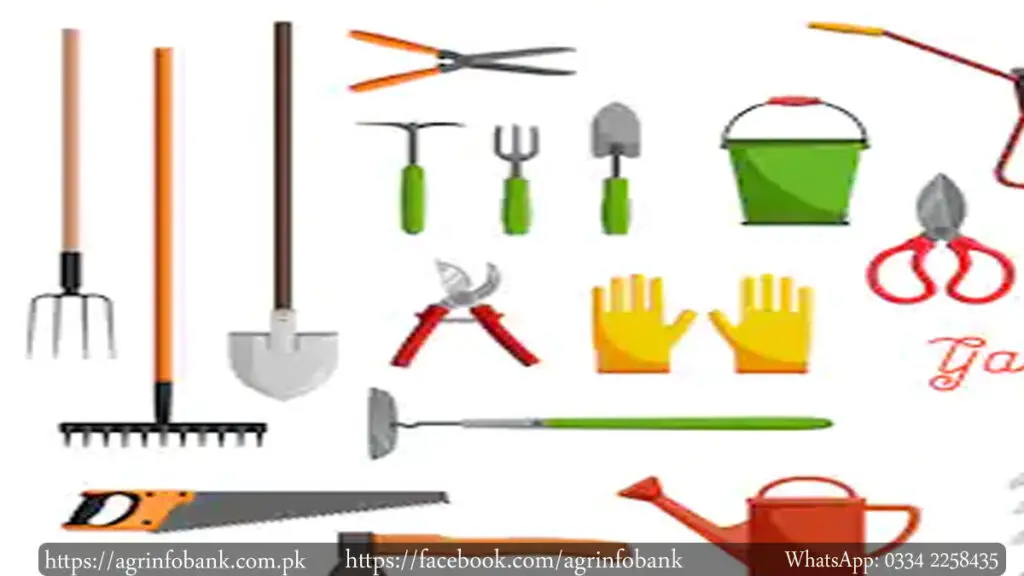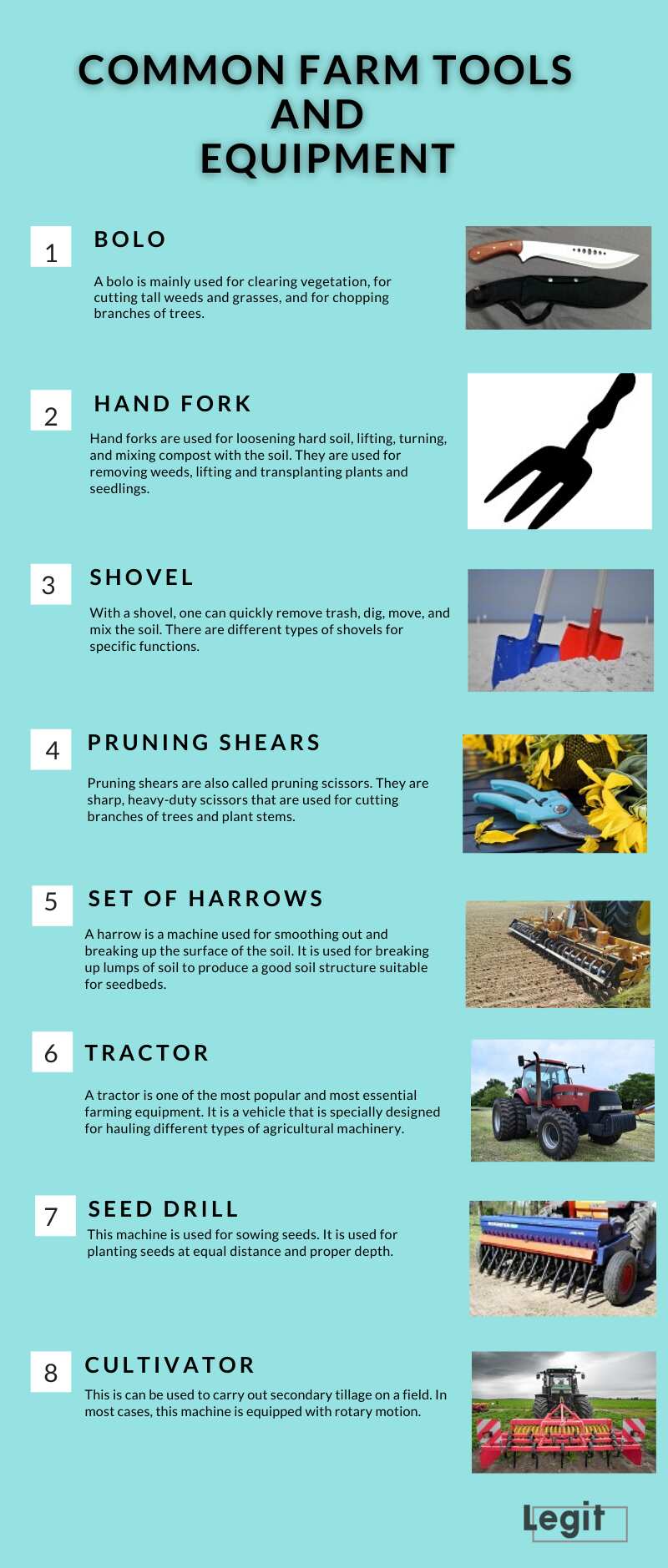This post may contain affiliate links which means I may receive a commission for purchases made through links. Learn more on my Private Policy page.
When it comes to running a successful farm, having the right tools can make all the difference. From tilling the soil to harvesting crops, the essential farm tools are the backbone of any agricultural operation. In this article, you’ll discover a comprehensive list of must-have tools that every farmer should have in their arsenal. Whether you’re a seasoned farmer looking to upgrade your equipment or a beginner just starting out, this guide will provide valuable insights to help you make informed decisions about the tools that will best suit your needs. So, let’s explore the world of essential farm tools and equip yourself for a bountiful and efficient farming experience.
Tractors
Tractors are an essential tool for farmers, providing the power and versatility needed to accomplish a wide range of tasks on the farm. These robust machines come in various types and sizes to suit different farming needs.
Tractor types and sizes
There is a wide range of tractor types and sizes available in the market, each designed to tackle specific farming tasks. Compact tractors are smaller in size and are perfect for small-scale farming operations or tasks that require maneuverability in tight spaces. On the other hand, utility tractors are larger and more powerful, suitable for heavy-duty tasks such as plowing fields or hauling heavy loads.
Implement attachment options
One of the key advantages of tractors is their ability to accommodate various implement attachments, expanding their functionality and making them even more versatile. Some common implement attachments include front-end loaders, backhoes, tillers, and mowers. These attachments can be easily added or removed to cater to specific tasks, allowing farmers to maximize the use of their tractors throughout the year.
Benefits of using tractors
The use of tractors brings numerous benefits to farmers. Firstly, tractors save a significant amount of time and labor, enabling farmers to accomplish tasks more efficiently. With the power and strength of a tractor, work that would previously take days or weeks can now be completed in a fraction of the time. Additionally, tractors help improve productivity by enabling farmers to work on a larger scale, covering more acres and increasing yields. Moreover, tractors can also reduce the physical strain and fatigue experienced by farmers, as the machine takes care of the heavy lifting.
Tillage Equipment
Effective tillage is crucial to prepare the soil for planting and ensure optimal growing conditions for crops. Tillage equipment plays a vital role in this process.
Ploughs
Ploughs are commonly used tillage equipment that is used to turn over and break up the soil, making it ready for planting. These tools are available in various designs, including moldboard ploughs, chisel ploughs, and disc ploughs, each suitable for different soil and crop types. Ploughing helps loosen the soil, improve soil moisture penetration, control weeds, and promote better seed-to-soil contact.
Harrows
Harrows are essential tools for leveling the soil surface after ploughing and breaking down larger soil clumps. They help to create a smooth and even seedbed, which is crucial for proper seed germination and uniform plant growth. Harrows can also be used to incorporate fertilizers or soil amendments into the soil and control weeds by disturbing their growth.
Cultivators
Cultivators are used for shallow tillage operations, mainly to control weeds or prepare the soil for planting in already tilled areas. These tools are designed to disturb the soil surface without turning it upside down. They often come with adjustable tines or blades, allowing farmers to modify their width and depth, depending on the task at hand.

This image is property of environment.co.
Planting and Seeding Equipment
Planting and seeding equipment play a vital role in establishing crops in the field. These tools help ensure accurate seed placement, proper seed-to-soil contact, and uniform seed distribution.
Seed drills
Seed drills are commonly used for large-scale planting operations. These machines are designed to sow seeds in evenly spaced rows at a consistent depth, ensuring optimal seed-to-soil contact. Some seed drills also come with additional features like fertilizer attachment, allowing simultaneous application of fertilizers during sowing.
Transplanters
Transplanters are essential tools for farmers who prefer transplanting seedlings rather than direct seeding. The machines automate the process of transplanting seedlings into the field, ensuring accurate spacing and depth. Transplanters not only save time and labor but also enhance crop uniformity and reduce transplant shock, resulting in improved plant establishment.
Planters
Planters, similar to seed drills, are used for precise seed placement. These machines are especially useful for crops that require precise seed spacing, such as corn or soybeans. Planters come with various attachments and features, such as seed meters and depth control mechanisms, ensuring accurate and consistent seed placement.
Seedling trays
Seedling trays are rectangular or square containers used for germinating and growing seedlings before transplanting them into the field. These trays provide a controlled environment for seed germination and early seedling growth, allowing farmers to start crops earlier and extend the growing season. Seedling trays help minimize transplant shock and ensure healthy seedlings for field establishment.
Irrigation Tools
Proper irrigation is crucial for crop growth and productivity, especially in areas with irregular rainfall patterns or limited water availability. Various irrigation tools can help farmers efficiently manage water resources.
Sprinklers
Sprinklers are widely used irrigation tools that distribute water over crops in a controlled manner. These tools use pressurized water and sprinkler heads to disperse water droplets over the field, imitating rainfall. Sprinklers are suitable for a wide range of crops and field sizes and can be customized to deliver water in specific patterns depending on crop requirements.
Drip irrigation systems
Drip irrigation is a highly efficient method of providing water directly to the roots of plants. This system consists of thin tubes with emitters placed near each plant, delivering water drop by drop. Drip irrigation minimizes water wastage and reduces weed growth since the water is delivered precisely where the plants need it. It is particularly beneficial for areas with limited water availability or when precise water control is needed.
Hoses and pipes
Hoses and pipes are essential for transporting water from its source to the irrigation tools. Flexible hoses are often used for smaller-scale irrigation operations or when water needs to be moved frequently. Pipes, on the other hand, are designed for larger-scale irrigation systems and provide a more permanent and reliable water distribution infrastructure.
Pumps
Pumps are crucial components of irrigation systems, as they provide the necessary pressure and force to move water through hoses or pipes. Pumps come in various sizes and capacities, allowing farmers to choose the most suitable option based on their water source and irrigation needs. With the right pump, farmers can ensure a consistent and reliable water supply for their crops.

This image is property of classnotes.ng.
Harvesting Equipment
Harvesting is the culmination of months of hard work for farmers, and having the right equipment can make this task much more efficient and productive.
Combine harvesters
Combine harvesters, also known as combine harvesters, are powerful machines that automate the process of harvesting grain crops, such as wheat, corn, or rice. These machines combine several operations into one, including reaping, threshing, and winnowing, saving farmers significant time and labor. Combine harvesters can harvest large quantities of grain in a short period while ensuring minimal loss and maintaining crop quality.
Threshers
Threshers are used to separate the grains from the chaff, which is the protective covering around the seeds. These machines are particularly useful for crops like wheat, oats, or barley, where the valuable part of the plant is the grain. Threshers can be operated manually or through an electric or engine-driven mechanism, depending on the scale of operations.
Harvesting sickles
Harvesting sickles are handheld tools used for manually cutting crops close to the ground. These tools are often used for small-scale harvesting operations or when harvesting in areas that are not accessible to machinery. Harvesting sickles come in different sizes and blade shapes, allowing farmers to choose the most appropriate option based on crop type and personal preference.
Baling machines
Baling machines are used to compress harvested crops, such as hay or straw, into compact bales for easy storage and transportation. These machines not only save significant labor and time but also protect the harvested material from weather elements, ensuring its quality and value. Baling machines come in various sizes, from small manual ones suitable for small-scale operations to large, fully automated systems for commercial use.
Livestock Handling and Care Tools
For farmers involved in livestock production, having the right equipment for handling and caring for animals is essential for the health and well-being of the animals and the efficiency of farm operations.
Fencing equipment
Fencing equipment is crucial for creating boundaries and enclosures for livestock. This includes materials such as wire, posts, and electric fences. Fences play a vital role in keeping animals safe, preventing them from wandering off or entering restricted areas, and protecting them from predators. Proper fencing ensures the efficient management and control of livestock movements, facilitating rotational grazing and allowing farmers to manage their pastures effectively.
Feeding solutions
Feeding solutions for livestock can vary depending on the type and scale of the operation. This can include feeding troughs, hay racks, automatic feeders, and waterers. These tools help provide animals with a consistent and appropriate diet, ensuring their nutritional needs are met. Automated feeders and waterers can also save labor and provide a constant supply of food and water to animals.
Watering equipment
Access to clean and fresh water is essential for livestock health and productivity. Watering equipment includes tools such as water troughs, automatic waterers, and watering tanks. These tools ensure a reliable and clean water supply for animals, minimizing the risk of water-borne diseases and dehydration. Adequate watering equipment also supports proper digestion and nutrient absorption in animals.

This image is property of netstorage-legit.akamaized.net.
Storage and Handling Equipment
Storage and handling equipment are vital for efficient and effective management of harvested crops, ensuring their quality and value are maintained.
Grain silos
Grain silos are cylindrical structures used to store harvested grains such as wheat, corn, or rice. These structures provide a controlled environment to preserve the quality and quantity of the stored grain. Grain silos protect the grain from pests, moisture, and other environmental factors, preventing spoilage and maintaining its nutritional value. Silos come in various sizes and can be designed for above-ground or underground installation.
Bulk handling systems
Bulk handling systems, such as augers, conveyors, and elevators, are used for efficiently moving harvested crops from one location to another. These systems can transport large volumes of grains, allowing farmers to load and unload crops from storage facilities, trucks, or processing equipment quickly. Bulk handling systems are available in various designs and capacities to accommodate different scale operations and specific crop handling needs.
Conveyors
Conveyors are used to transport crops or other materials horizontally or vertically. These machines consist of belts or chains with attached buckets or trays that move materials from one point to another. Conveyors are commonly utilized in grain handling, allowing farmers to efficiently move crops between different stages of the harvesting or processing operations.
Protective Gear and Safety Equipment
Working on a farm can be physically demanding and potentially hazardous. Having the proper protective gear and safety equipment is crucial for ensuring the well-being and safety of farmers and workers.
Safety goggles
Safety goggles are essential for protecting the eyes from dust, debris, chemicals, or any other potential hazards that may be encountered during farm operations. These goggles cover the eyes completely and provide a barrier against splashes, impacts, or airborne particles. Safety goggles should be worn whenever there is a risk of eye injury, such as when operating machinery or handling chemicals.
Gloves
Gloves are an important part of personal protective equipment (PPE) on the farm, providing hand protection against cuts, abrasions, chemicals, or extreme temperatures. Different types of gloves are available, including leather gloves for general use, chemical-resistant gloves for handling pesticides or fertilizers, and heat-resistant gloves for working with hot surfaces or equipment. Choosing the appropriate gloves depends on the specific task and potential hazards involved.
Ear protection
Farmers are often exposed to loud noises from machinery, which can lead to hearing damage or loss over time. Wearing ear protection, such as earplugs or earmuffs, helps reduce the risk of noise-related hearing problems. It is essential to use proper ear protection whenever operating loud machinery or working in noisy environments for an extended period.
Respirators
Respirators are crucial for protecting farmers and workers from inhaling harmful dust, chemicals, or fumes that may be present in the farming environment. These devices create a seal around the nose and mouth, preventing the entry of potentially dangerous substances. Respirators should be used whenever there is a risk of exposure to airborne contaminants, such as when applying pesticides or working in dusty conditions.

This image is property of i0.wp.com.
Hand Tools
Hand tools are invaluable for various farming tasks, whether it’s tending to crops, managing livestock, or maintaining farm infrastructure.
Shovels
Shovels are versatile tools used for various purposes on the farm. They are commonly used for digging, moving soil, spreading fertilizer, or cleaning livestock areas. Shovels come in different sizes and designs, including square-point, round-point, or garden shovels, each suited to specific tasks.
Rakes
Rakes are essential for leveling the soil, collecting debris, or moving materials. They are commonly used in garden or crop beds, as well as for cleaning animal barns or outdoor spaces. Rakes come in different types, including garden rakes, hay rakes, and lawn rakes, each designed for a specific purpose.
Hoes
Hoes are versatile tools used for cultivating the soil, removing weeds, or shaping garden beds. They come in various shapes and sizes, including draw hoes, chopping hoes, and scuffle hoes. Hoes are particularly useful for maintaining vegetable gardens or preparing seedbeds.
Forks
Forks are essential for handling different materials on the farm, such as hay, straw, or compost. They are designed with multiple curved tines, allowing for efficient lifting and transportation of materials. Forks come in various types, including manure forks, pitchforks, or hay forks, each suited to specific tasks.
Power Tools
Power tools provide additional efficiency and convenience to farmers, allowing them to tackle tasks more quickly and effectively.
Chainsaws
Chainsaws are versatile power tools used for cutting trees, pruning branches, or preparing firewood. They come in various sizes and power options, from small electric chainsaws suitable for light-duty tasks to larger gasoline-powered ones for more demanding jobs. Chainsaws simplify tasks that would otherwise be time-consuming and labor-intensive.
Grinders
Grinders, or angle grinders, are multipurpose power tools used for cutting, grinding, or polishing various materials. They come with different types of discs or attachments, allowing farmers to tackle tasks such as sharpening tools, cutting metal, or grinding animal feed. Grinders make it easier to complete precise and challenging work quickly and efficiently.
Drills
Drills are essential for drilling holes, driving screws, or mixing materials. They come in various sizes and power options, including cordless drills, electric drills, or powerful rotary drills. Drills are valuable tools for farmers, as they enable them to perform tasks such as installing fences, assembling farm structures, or even planting crops efficiently.
Impact wrenches
Impact wrenches are powerful tools used for loosening or tightening bolts and nuts. They provide high torque and work using repeated rotational impacts, allowing farmers to tackle heavy-duty tasks quickly and effortlessly. Impact wrenches are often used for machine maintenance, vehicle repair, or assembly tasks on the farm.
In conclusion, the essential farm tools every farmer should have greatly depend on the specific farming activities they engage in. Tractors, tillage equipment, planting and seeding equipment, irrigation tools, harvesting equipment, livestock handling and care tools, storage and handling equipment, protective gear and safety equipment, hand tools, and power tools all play essential roles in different aspects of farming. By equipping themselves with the right tools, farmers can enhance productivity, save time and labor, and ensure the success of their farming operations.

This image is property of sf.ezoiccdn.com.
This post may contain affiliate links which means I may receive a commission for purchases made through links. Learn more on my Private Policy page.

